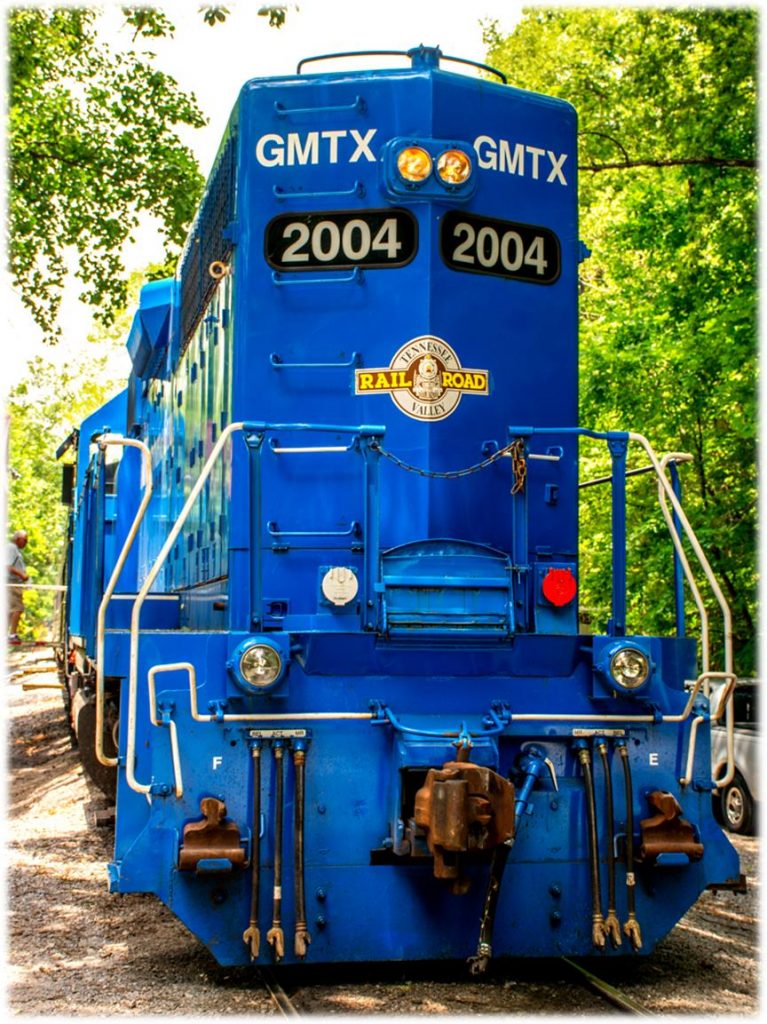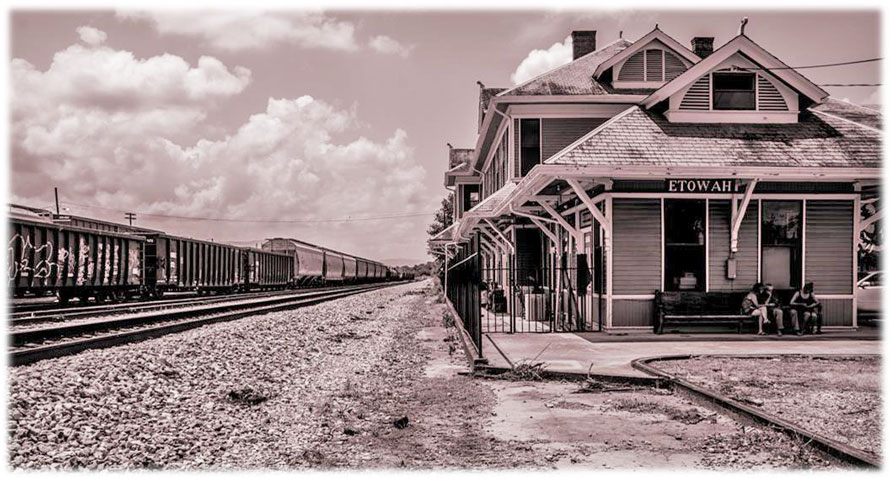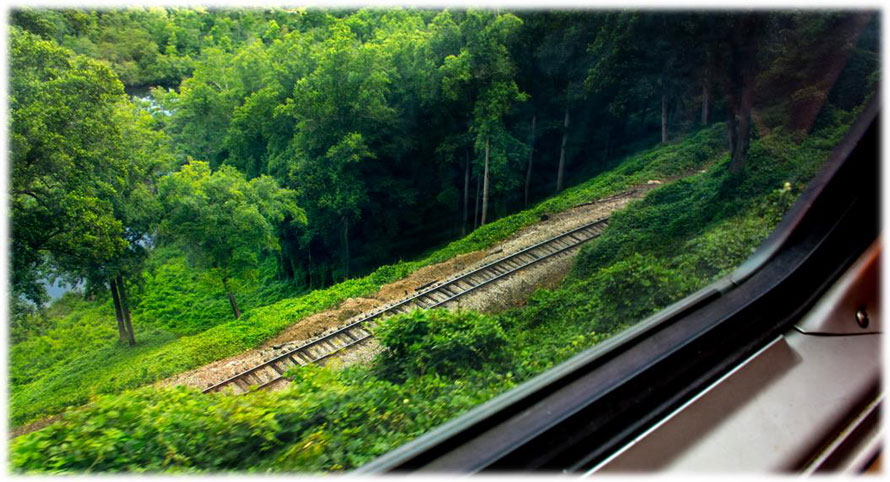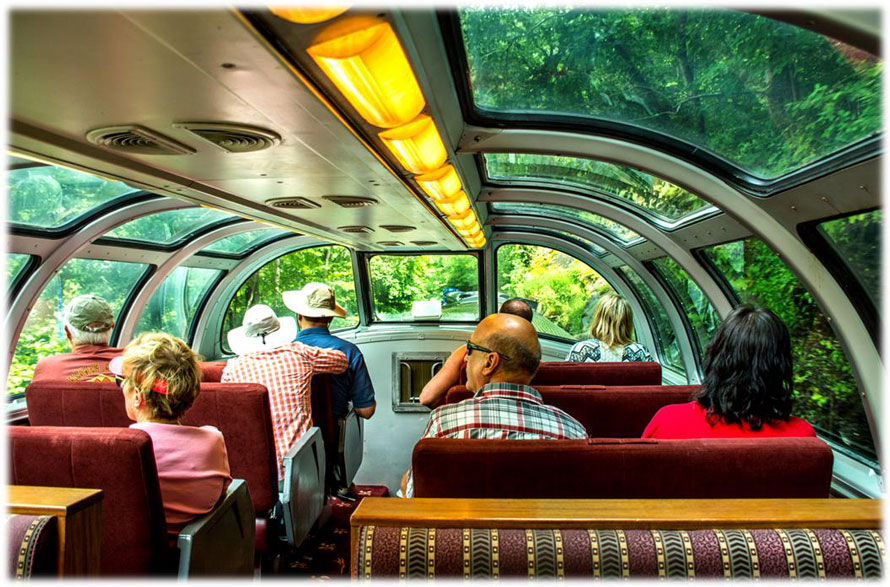
In East Tennessee there’s a very nice excursion railroad, called the Tennessee Valley Railroad. It offers a short run option from Chattanooga up to Missionary Ridge, through a hand cut, Civil War era tunnel, behind one of a variety of nicely restored steam locomotives. At the top, there’s a turntable and you can watch them turn the steamer around—very cool!
Or, you can board a three and one-half hour run called the Hiwassee Loop, departing from Etowah Tennessee, south of Knoxville, and re-live the glory days of the Louisville & Nashville’s passenger service over the L&N’s mountain lines that wind east and south toward Georgia alongside the scenic Hiwassee River.
This past month, my brother Keith and I did the Hiwassee Loop after camping at Russ Martin’s beautiful creek side spot just off Rt 24 at the Martin Springs exit.
Here’s the depot in Etowah, and for the size of that town, this depot is quite large (still decked out in July 4th bunting).

I tried to capture the spirit of the Etowah Depot with a sepia shot, but the passenger boarding siding has been removed, and the CSX main line has only a couple of other utility sidings for staging rolling stock . Still the waiting passengers sitting on the solid oak benches under the gables lends an authentic air.

The depot houses a small area (not quite a museum) where they have some very clean looking cash registers from the 1930’s, and if you listen closely you can still hear the clack of the keys, the chime of the bell, and the jangle of the cash drawer as it slides open for your change

Imagine the number of keystrokes it would take to calculate the current known value of PI (over 31 trillion digits so far in 2019) using this mechanical marvel.

Since the Etowah Depot sits on the CSX main line and you can’t board there, there is a short bus ride to the Hiwassee/Ocoee Rivers State Park where you board the excursion consist

Here you learn a bit about the Hiwassee Loop and how it fits in railroad engineering history.
First, you must understand that although locomotives are very powerful, they still must pull a very heavy train. If the weight of the train is too great, or the pitch of the road is too steep, then the steel wheels of any locomotive will simply spin on the steel rails.
The main consequence of this is that railroad tracks do not climb up hills at a very steep rate, typically no more than three percent, or three feet of vertical rise over 100 feet of distance.
The mountains that rise between Tennessee and Georgia near Etowah are on the order of 900 feet in elevation. If you do the math, that means the rails need to be around 30,000 feet long, or almost 5.7 miles to climb to the top. The problem is that there is not a continuous run this long on the mountain.
The first solution was installing switchbacks, where the locomotive and up to four cars were run onto a dead end piece of track through a switch. After this subset of cars were all sitting on the dead end spur, the switch would be thrown to feed the train onto the next ascending stretch of track and they would have to back up the hill to the next switchback, where the whole process would happen again, this time with the train pulling forward on the next ascending link of tracks.
It could literally take all day to get a 100 car coal train up over the mountain in this manner. It didn’t take the railroad long to figure out that this was not a workable solution. The fix was to build tracks that circle up the mountain, like the threads on a wood screw, then build a trestle where you pass over top of the tracks you just came up, forming a loop.
Here’s a US Geological Survey photo of the Hiwassee loop, and you can see the multiple encirclements of the track, then the trestle where it passes over itself. I put in the green dots to highlight the tracks and the Hiwassee river can be seen on the right.

So with a full understanding of the engineering challenges these railroads tackled, you finally get to board the train.
There are no steam locomotives running on this part of the line, so the TVRR leases a GP38 diesel electric locomotive from GMTX.

If you ever wondered who has the coolest job in the world, here he is, the engineer on this train.

Keith and I had tickets for the coolest car in the consist as well, the dome car—now this is the way to travel. Porter, I’d like another highball, please.

Downstairs from the observation dome is the rear lounge area—SUITE!

Looking back up the curved staircase into the observation dome

Next time you’re flying commercial class, and your knees have been jammed up under your chin for several hours, think about being able to walk around in this much space, any time you want and no seatbelt light!

Need a breath of fresh air ? Just walk out to the area between cars, where you can lean your head out an open window.

But always be careful sticking your head out of a moving train because around the next bend the train traverses a narrow. handmade cut through the rocks, and you could lose it. This one allowed mere inches of clearance.

Or just safely hypnotize yourself by gazing sleepily as the tracks recede in the rear window.

There’s always the beautiful, ice cold Hiwassee River flowing past.

Many folks ride the river and look back at you riding the train.

Soon you suddenly notice that you’ve been climbing steadily, as you see the river, now hundreds of feet below the train.

Hey, we were just traveling along those tracks way down there!

Sho’ nuff’— you’re going to be passing below the Hiwassee Loop Trestle, and there it is.

After you pass under the trestle you continue to climb up and around the mountain. As you ascend the corkscrew, you come to the very trestle you passed below just minutes ago.

Glancing down you see the same tracks you were just riding on.

And so you have climbed the mountain, and with no time wasted dealing with switch backs. After a quick stop where they move the locomotive to what was the rear of the train, you start back down the mountain, and it’s deja vu all over again, except in reverse.
Now, the locomotive is connected to the observation car, and presents a slightly different view.

All too soon the ride down the mountain is over with. Still, I keep a movie running in my head of what it was like to ride rails as a primary mode of transportation.
Maybe I was born forty years too late.

May the rails rise up to greet you.
Thanks for posting. Sad that I had to cancel.
Love those photos – and the Algonquin Park on the end! It looks like a great ride.
I didn’t watch all the way thru the first time you sent the link. Today i “found it”! What a really cool presentation. Nicely done Kurt!